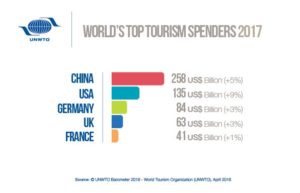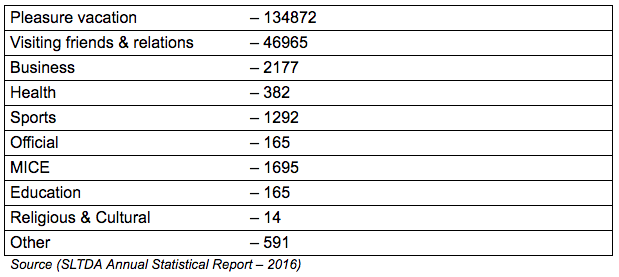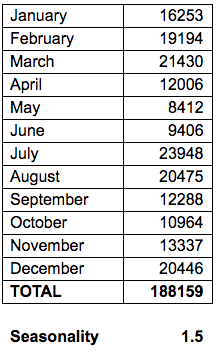TABLE OF CONTENTS
01. Introduction on United Kingdom and Its Tourism Industry
When it comes to travel and leisure industry, the United Kingdom (UK) ranks as originate place of industrial revolution two centuries ago. Mass scale leisure travelling also started from the United Kingdom in 1841 when Thomas Cook introduced the leisure trips to his customers. There onwards, industry expanded best known as “Travel & Hospitality Industry” expanding its limits to infinity.
While travel & tourism industry is one of the economically valuable industries in the world, the population of the United Kingdom with 65 millions of people (0.008% of the world population) had been performing well in the travel industry who used to have the biggest empire on earth less than a century ago.
United Kingdom is the fifth largest economy in the world, comprising 3.5% of world GDP. When it comes to tourism, United Kingdom is the 4th largest tourism spender in the world according to UNWTO report. There are 70 million foreign trips recorded from the country.

1.1 Historical Relationship Of Sri Lanka & United Kingdom & Colonial Effect On The Tourism Industry In Sri Lanka
Sri Lanka used to be a historical centre for international trading. Hence, there are number of ancient references to Sri Lanka by foreigners who visited the country such as Iban Bathutha, Robert Knox etc. However basic infrastructure and faculties needed for travel and tourism industry were built during the colonial time.
According to Fernando, S., Bandara, J., & Smith (2006) initial infrastructure and amenities were built but not specifically aiming at tourism. Some luxury accommodation was built colonial time planters, governors and other visitors. Those luxury accommodation facilities were converted to star class hotels which were later used for tourism and hospitality industry.
Galleface Hotel; iconic city hotel of Colombo was built by four entrepreneurs in 1864 and later converted into a luxury hotel. Mount Lavinia Hotel has glorious story behind its creation by Sir Thomas Maitland who used to be the governor of Sri Lanka. The Grand Hotel is another fabulous colonial hotel located in Nuwaraeliya used to be a holiday home of the 5th Governor of Sri Lanka Sir Edward Barnes. Apart of these star class luxury hotels, there are several guest houses located all around the country which were built during the colonial period.
Apart from the accommodation facilities which help to establish the industry, the other important factor established by the British colonials were the basic infrastructure facilities which were developed later. The road network and most importantly railway network was built by the British directly advances not only the tourism industry but also every industry of the country.
2. Outbound Tourism of United Kingdom
As stated above, the United Kingdom is the place which originated the leisure travel to the World. Being the country which started the industrialisation and which used to have the biggest colonial empire in the world, the wealth belonged to British people allow them to travel, explore and relax abroad. According to the statistics taken from Office for National Statistics UK, from 1980 to 2016 number of visits by the UK residents have grown up from 17 million to nearly 71 million which is an average annual growth of 4%. Most significantly, the spending done abroad by the UK residents have grown up from £2738 million to £ 43000 which is 8% of annual growth. The growth rate of spending is drastical during 80’s and 90’s and it has a negative affect or slow increase just before and after the recession in 2009.
Despite the slowdown in economic growth, European outbound travel has grown by 3%. Globally, United Kingdom is one of the top five spenders in outbound tourism. Outbound travel is increasing steadily in the United Kingdom along with domestic and inbound tourism. According to the Office for National Statistics of the UK, residents of the United Kingdom made 70.4 million outbound trips in 2016, which is a 7% increase compared to 2015. Trips taken as holiday remained the main purpose of the trip for UK outbound tourists in 2016 followed by visiting friends and relatives and business trips. According to the World Travel and Tourism Council, the outbound tourism expenditure of UK travelers crossed US$ 70 billion and is projected to reach US$ 102 billion by the end of 2024. The outbound travel sector in the United Kingdom provides employment on par with other well-known and recognized industries, such as food and electrical equipment manufacturing and machinery and equipment industries.
Relatively, high disposable income per capita is expected to drive the United Kingdom’s outbound tourism sector. Baby Boomers, with more free time and money for travel, are the most important segment of the UK outbound travel sector. The baby boomer generation has topped the market share of the UK outbound travel sector mainly attributed to the recent changes in pension annuities. According to the International Passenger Survey, the residents of UK prefer July and August for travel abroad mainly due to the long school holidays. Other popular months are April, May, June, October and November. January to March is a popular time for single-week ski trips and winter sun breaks to cheap destinations, usually as an extra holiday. Along with the international airports, the United Kingdom has many regional airports offering international services to important destinations which include Manchester, Nottingham, East Midlands, Liverpool and Leeds.
Medical tourism across the globe also faced difficulties in the last couple of years. Outbound medical tourism from Britain has recovered slowly after the recession. Factors including poor National Health Service delivery, problems with National Health Service dentistry, and objections and delays relating to National Health Service has encouraged the medical tourism. Reforms have helped boost the outbound tourism sector in the UK. The residents of the UK seek cheap medical treatment abroad and look for countries such as Poland and Bulgaria for medical help.
However, factors such as the increase in the price of travelling from the UK due to higher fuel costs and slowness of the economic climate can adversely impact the UK outbound tourism sector. In addition, the threat of terrorism is another factor which is impacting the UK outbound tourism sector as travelers are more cautious about the safety level of the destination country. Furthermore, a recent depreciation of the Euro against the US Dollar has made it more expensive for UK residents who travel abroad. However, some countries outside the common currency limitations experienced positive performance, especially medium-haul destinations around the Mediterranean coast.
2.1 Demand, Recent Trends & Patterns of UK Outbound Travel Industry.
City breaks are the most popular holiday pattern of UK residents. When it comes to travel abroad, beach stays are in high demand which have made Spanish, Greek, Southern France and other Mediterranean beaches loaded with British tourists. However, there are number of travel patterns growing among UK tourists within the recent past.
2.1.1 River Cruises
River cruising is the fastest-growing sector of the worldwide cruise market with many new vessels being introduced, together with new facilities to rival ocean liners. The majority of growth comes from European cruises, with the Rhine/Moselle followed by the Danube leading the way as the most popular routes. Popular new development within this sector is the growth of more active trips, where holidaymakers can combine taking in the scenery with activities such as hiking along smugglers’ routes, sampling local specialties or rock climbing.
2.1.2 Responsible Tourism
According to a research done by ABTA (Association of British Travel Agents) 70% of people now believe that travel companies should ensure that their holidays help the local people and economy. Following the huge public rise in sentiment for programmes such as David Attenborough’s ‘Blue Planet II’ – the most watched programme of 2017 – and campaigns like Sky News’ Ocean Rescue Scheme, this trend looks set to continue and take center stage in 2018. With a greater public awareness, not only of environmental issues, but also of human rights and working conditions, tour operators and hoteliers are supporting this move towards responsible tourism that looks after our environment and our people.
In 2018, we can expect more initiatives such as social enterprise projects which give back to local communities, carbon-neutral group tours and the banning of plastics from beaches. The welfare of animals in tourism has become a mainstream issue, with Thomas Cook committing to remove animal excursions such as elephant rides and swimming with dolphins from their activities list. Virgin Holidays also announced they will no longer sell or promote any new attractions or hotels that feature captive whales and dolphins.
2.1.3 Micro adventures
An increasing drive for healthier lifestyles is spilling over into the way we holiday according to Euro Monitor’s Global Trends Report 2016, and the micro-adventure is a key component of this trend.
From white water adventures in London’s Lea Valley to kayaking in the Loire valley, horse-riding in Andalucía to climbing Mount Vesuvius or enjoying one of Budapest’s spas, microadventures can be affordable and easily achievable. Almost one in ten (9%) people took an activity holiday in 2016 according to ABTA research 2018, and the micro-adventure looks set to boost this further within the upcoming years.
3. British Holidaymakers and Sri Lankan Tourism.
The United Kingdom is one of the top ten source markets of Sri Lankan tourist arrivals. It is not because of the numbers but, UK is one of main luxury clientele in Sri Lanka.
The UK is placed at the third highest number of arrivals as against the India and China, which are at the second and first respectively. However, India and China consist of low spending clientele to Sri Lanka while the UK is the most important clientele of Sri Lankan tourism industry.
The UK market is growing steadily. The arrivals were affected due to the recession but after 2010 the number of arrivals are steadily growing.

Arrivals from United Kingdom to Sri Lanka
Average stay of an UK travelers is 14.7 (in 2015) which is higher than all average stays of 10.3 (2015) which shows why the market is important for Sri Lanka.
In 2016, Male and Female arrivals were shown as follows,
- Male – 89122
- Female – 99037
3.1 UK Arrivals by Age Group

Source (SLTDA Annual Statistical Report – 2016)
According to “The Guardian” newspaper people over 65 years of age has the highest proportion of disposable income to spend on leisure which is the biggest contributor of Sri Lankan arrivals. On the same study it shows that spending on recreation and culture among under 30s was almost half that of those between 65 and 74, who shelled out almost a fifth of their disposable income on this category.
According to the purpose of visit, leisure is on top and due to the large number of diaspora in the UK, visiting friends and relations are also high. Non-significant number of visitors are arriving in other categories as well. MICE and Health shows the potential areas for future growing.
3.2 Purpose of Visit

3.3 Mode of Transport
- Air – 183781
- Sea – 4378
According to the latest holiday trends presented by ABTA, cruises are emerging with 14% annual increase in 2018. Attracting cruises is another potential tourism segment to Sri Lanka.
3.4 Arrivals Distribution Throughout The Year

Source (SLTDA Annual Statistical Report – 2016)
The UK is a traditional seasonality setter of Sri Lankan tourism as the season are divided based on European seasons. Similar to the rest of the European holiday makers, most popular arrival times are peak winter in December and January and July & August during summer holidays. Diaspora community regularly visits Sri Lanka during summer holiday which makes July at the highest arrival month of the year from UK to Sri Lanka.
4. Prospects and Key Challenges
4.1 High Air transportation cost
High prices on air tickets from European countries to Sri Lanka is one of main and common issues in attracting European customers to Sri Lanka. There is only one direct flight running from UK to Sri Lanka per day with Sri Lankan Airlines and flights are fully booked during the peak time in advance and rest of the tourists have to come via middle east or India. Due to the limited availability of flights, the cost during the peak time could avail tourist a luxury holiday somewhere closer to UK such as Spain, France or even Turkey rather than flying to Sri Lanka.
4.2 Lack of quality
The traditional hospitality industry of Sri Lanka is influenced by the European standards. Since majority of the industry is controlled by the informal sector such as transport, restaurants, night clubs etc, the lack of standards have badly influenced the UK clientele.
4.3 Lack Of Responsibility And Sustainable Initiatives
According to the study mentioned above, 70% of the UK citizens who travel abroad concerns about responsible tourism approach which means the money they spend for leisure will make the lives better off in host communities. Unfortunately, there are only tiny number of proper responsible tourism projects are running in Sri Lanka without government’s direct involvement.
4.4 Frauds, Scams and Violence
There are several frauds, scams incidents were reported against tourists who travel in Sri Lanka especially high spending UK tourists. There was even a murder case occurred couple of years ago which damaged the country’s reputation a lot.
4.5 Unavailability Of Room During The Peak Season
The UK high spending clientele is mainly seasonal oriented. During the peak period of the tourism, unavailability of high standard accommodation is a problem to bring them the best experience in Sri Lanka.
4.6 Lack of Innovation
Lack of innovation is not only a problem in tourism industry but as a community it is a huge downall. Innovation can make the people’s lives easy and in tourism industry it will provide alternative ways to enjoy the country. As a innovation friendly country, UK clientele intend to have personalised experiences with high standards of services.
4.7 Traditional Experiences Vs Commercialisation
Due to the uncontrolled and unplanned tourism development in Sri Lanka, have led some of the rural areas to over commercialisation. Because of that the community lives have been changed and ultimately local communities were forced to leave the area. The tourists who would like to experience the traditional local lives in specific areas will not get that experience but highly priced services. This has ruined the reputation of the country as a tourist destination.
5. Recommendations and suggestions
5.1 Affordable Airlines
If there are no any outside service providers operating to the UK to Sri Lanka, our national carrier Sri Lankan Airlines need to operate special transfer services at least during the peak season to reduce the sky-high air fares. Sri Lanka needs to introduce more value additions to spend inside Sri Lanka rather than just for air transport.
Attracting Maldives type high-end clientele
According to google keyword results, there are 2000 average google searches for the keyword “Holiday in Sri Lanka” while Maldives have 9000 average keywords searches. Maldives is positioned as a luxury holiday destination while Sri Lanka is still in mid-range of the clientele. High spending limited number of tourists is much useful rather than having large number of less spending travellers. However proper strategic plan need to be implemented to attract high spending holiday makers.
5.2 More Value Additions
Sri Lanka Tourism Strategic Plan 2017-2020 emphasises lack of value addition which is one of the key issues in Sri Lankan Tourism Industry. The UK clientele is more activity oriented and they prefer to actively participate and experience the several excursions offered by a country. Therefore, not only for UK but for the entire industry, it is highly important to introduce variety of value additions for the tourists who are travelling around Sri Lanka.
5.3 Niche Market Identification
One of the key strategies used by Thailand to attract European clients is to target the niche clientele such as solo travellers, religious tourists, meditation and wellness tourists. Sri Lanka also has a high potential of identifying niche clientele and targeting them which will influence entire tourism industry.
5.4 Service And Product Standardization
Certifications and international standards are required to organize to build the trust among the UK clients in various sectors such as health and safety, food and beverages and transport etc. As a country located far from the UK and not positively famous for trust and well practices, introducing such standards can increase the reputation of Sri Lanka.
5.5 Using The Large Diaspora To Promote The Country
Not only in the UK but in many European countries and best emerging markets such as USA, Canada and Australia have many Sri Lanka diaspora community settled and living. Every one of them can be a potential country ambassador who can promote the country among its community. The government should implement a plan to organize them and a methodology to get their contribution to promote Sri Lanka.
6. Conclusion
As a country which spending on tourism at the 4th largest in the World as well as the colonial state who used to acquire the country for more than a century, UK is the best potential market to get the highest income by attracting its high spending clientele. Since the hospitality industry atmosphere and customs were established on colonial values, it is much easier for the UK tourists to adopt for their leisure stay in the island. Already the flow of arrivals from the UK has started and what Sri Lanka need to do is to target more of its tourists by identifying the right clientele. Apart from the marketing and promotional aspects, all the other areas need to be prepared set for the tourism sector to perform with the UK outbound tourists.

